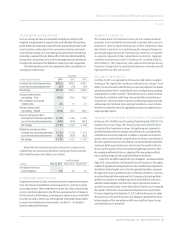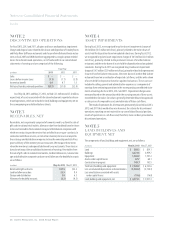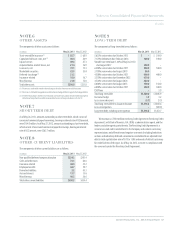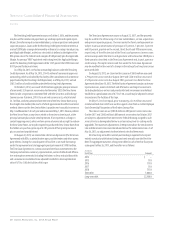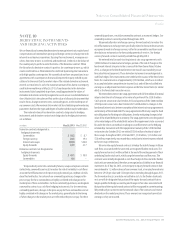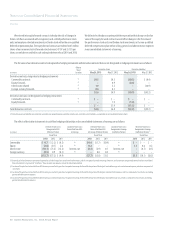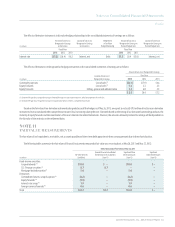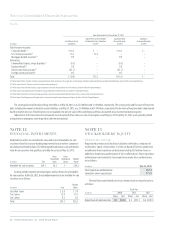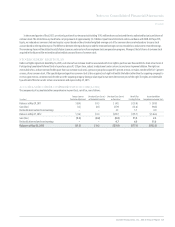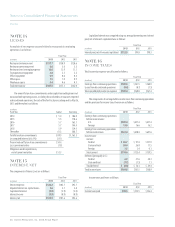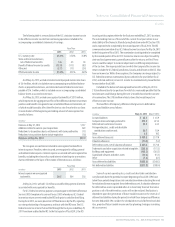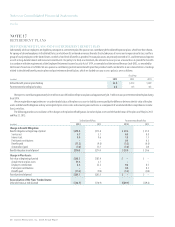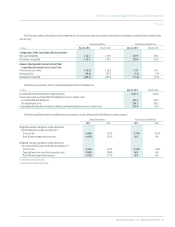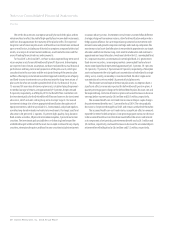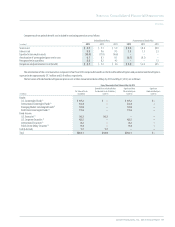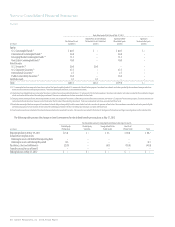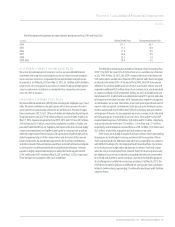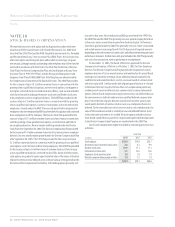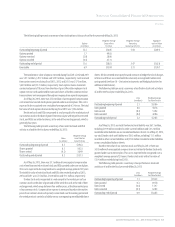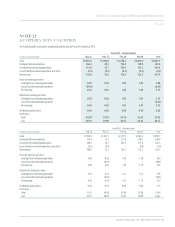Red Lobster 2013 Annual Report Download - page 59
Download and view the complete annual report
Please find page 59 of the 2013 Red Lobster annual report below. You can navigate through the pages in the report by either clicking on the pages listed below, or by using the keyword search tool below to find specific information within the annual report.
Notes to Consolidated Financial Statements
Darden
Darden Restaurants, Inc. 2013 Annual Report 55
The following table is a reconciliation of the U.S. statutory income tax rate
to the effective income tax rate from continuing operations included in the
accompanying consolidated statements of earnings:
Fiscal Year
2013 2012 2011
U.S. statutory rate 35.0% 35.0% 35.0%
State and local income taxes,
net of federal tax benefits 1.6 2.5 1.8
Benefit of federal income tax credits (12.9) (11.1) (8.3)
Other, net (2.7) (1.1) (2.4)
Effective income tax rate 21.0% 25.3% 26.1%
As of May 26, 2013, we had estimated current prepaid state income taxes
of $6.4 million, which is included on our accompanying consolidated balance
sheets as prepaid income taxes, and estimated current federal income taxes
payable of $16.5 million, which is included on our accompanying consolidated
balance sheets as accrued income taxes.
As of May 26, 2013, we had unrecognized tax benefits of $29.9 million,
which represents the aggregate tax effect of the differences between tax return
positions and benefits recognized in our consolidated financial statements, all
of which would favorably affect the effective tax rate if resolved in our favor.
A reconciliation of the beginning and ending amount of unrecognized tax
benefits follows:
(in millions)
Balances at May 27, 2012 $15.7
Additions related to current-year tax positions 16.9
Reductions to tax positions due to settlements with taxing authorities (1.1)
Reductions to tax positions due to statute expiration (1.6)
Balances at May 26, 2013 $29.9
We recognize accrued interest related to unrecognized tax benefits in
interest expense. Penalties, when incurred, are recognized in selling, general
and administrative expense. Interest expense associated with unrecognized tax
benefits, excluding the release of accrued interest related to prior year matters
due to settlement or the lapse of the statute of limitations was as follows:
Fiscal Year
(in millions)
2013 2012 2011
Interest expense on unrecognized
tax benefits $0.5 $0.4 $1.6
At May 26, 2013, we had $1.2 million accrued for the payment of interest
associated with unrecognized tax benefits.
For U.S. federal income tax purposes, we participate in the Internal Revenue
Service’s (IRS) Compliance Assurance Process (CAP) whereby our U.S. federal
income tax returns are reviewed by the IRS both prior to and after their filing.
During fiscal 2013, we were placed on CAP Maintenance by the IRS, signaling
our strong relationship of transparency and trust with the IRS team. The U.S.
federal income tax returns that we filed through the fiscal year ended May 29,
2011 have been audited by the IRS. In the first quarter of fiscal 2013, the IRS
issued a partial acceptance letter for the fiscal year ended May 27, 2012 tax return.
The outstanding item as of the end of the current fiscal year relates to our
deductibility of the Domestic Manufacturing Deduction under IRC Section 199,
and is expected to be completed by the second quarter of fiscal 2014. The IRS
commenced examination of our U.S. federal income tax returns for May 26, 2013
in the first quarter of fiscal 2013. The examination is anticipated to be completed
by the second quarter of fiscal 2015. Income tax returns are subject to audit by
state and local governments, generally years after the returns are filed. These
returns could be subject to material adjustments or differing interpretations
of the tax laws. The major jurisdictions in which the Company files income tax
returns include the U.S. federal jurisdiction, Canada, and all states in the U.S. that
have an income tax. With a few exceptions, the Company is no longer subject to
U.S. federal income tax examinations by tax authorities for years before fiscal
2012, and state and local, or non-U.S. income tax examinations by tax authorities
for years before fiscal 2009.
Included in the balance of unrecognized tax benefits at May 26, 2013 is
$18.6 million related to tax positions for which it is reasonably possible that the
total amounts could change during the next 12 months based on the outcome
of examinations. The $18.6 million relates to items that would impact our
effective income tax rate.
The tax effects of temporary differences that give rise to deferred tax
assets and liabilities are as follows:
(in millions)
May 26, 2013 May 27, 2012
Accrued liabilities $ 85.5 $ 65.9
Compensation and employee benefits 212.9 221.2
Deferred rent and interest income 83.3 61.3
Net operating loss, credit and charitable
contribution carryforwards 50.7 18.4
Other 6.8 10.2
Gross deferred tax assets $ 439.2 $ 377.0
Valuation allowance (15.4) (5.2)
Deferred tax assets, net of valuation allowance $ 423.8 $ 371.8
Trademarks and other acquisition related intangibles (205.6) (175.3)
Buildings and equipment (403.2) (363.3)
Capitalized software and other assets (19.4) (15.1)
Other (7.4) (6.5)
Gross deferred tax liabilities $(635.6) $(560.2)
Net deferred tax liabilities $(211.8) $(188.4)
Some of our net operating loss, credit and charitable contribution
carryforwards have the potential to expire beginning in fiscal 2014. We have
taken these potential expirations into consideration when evaluating the need
for valuation allowances against these deferred tax assets. A valuation allowance
for deferred tax assets is provided when it is more likely than not that some
portion or all of the deferred tax assets will not be realized. Realization is
dependent upon the generation of future taxable income or the reversal of
deferred tax liabilities during the periods in which those temporary differences
become deductible. We consider the scheduled reversal of deferred tax liabil-
ities, projected future taxable income and tax planning strategies in making
this assessment.


